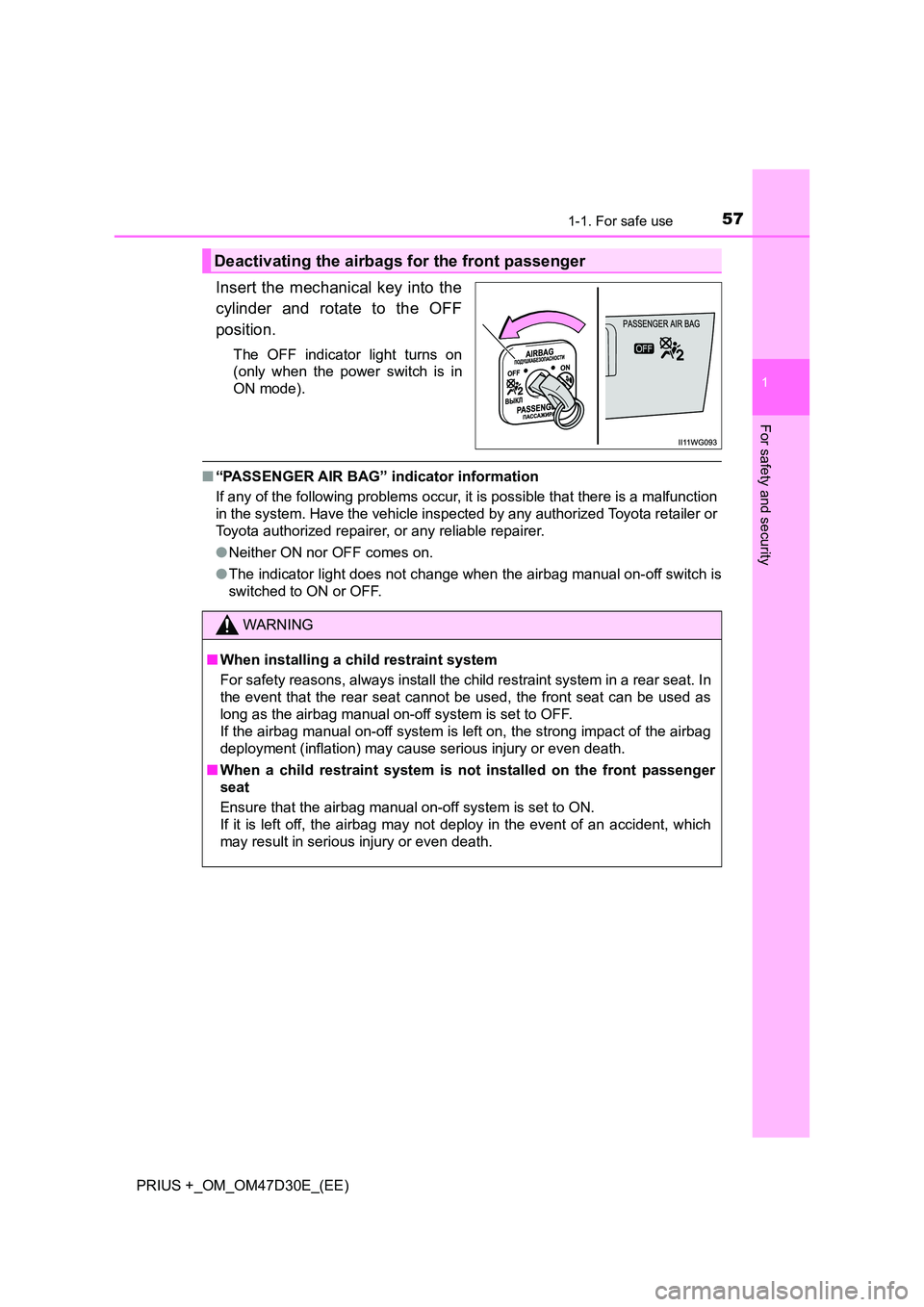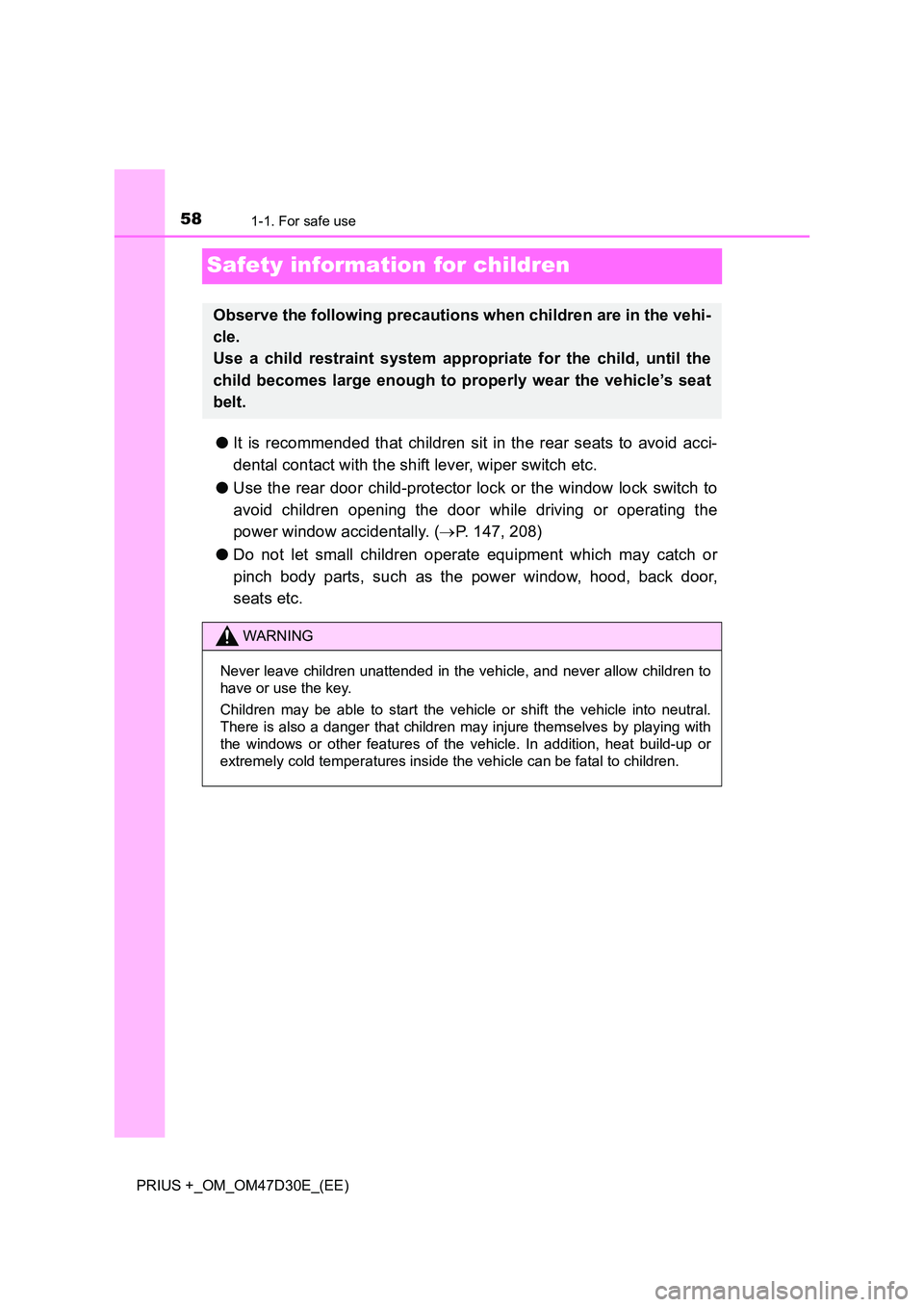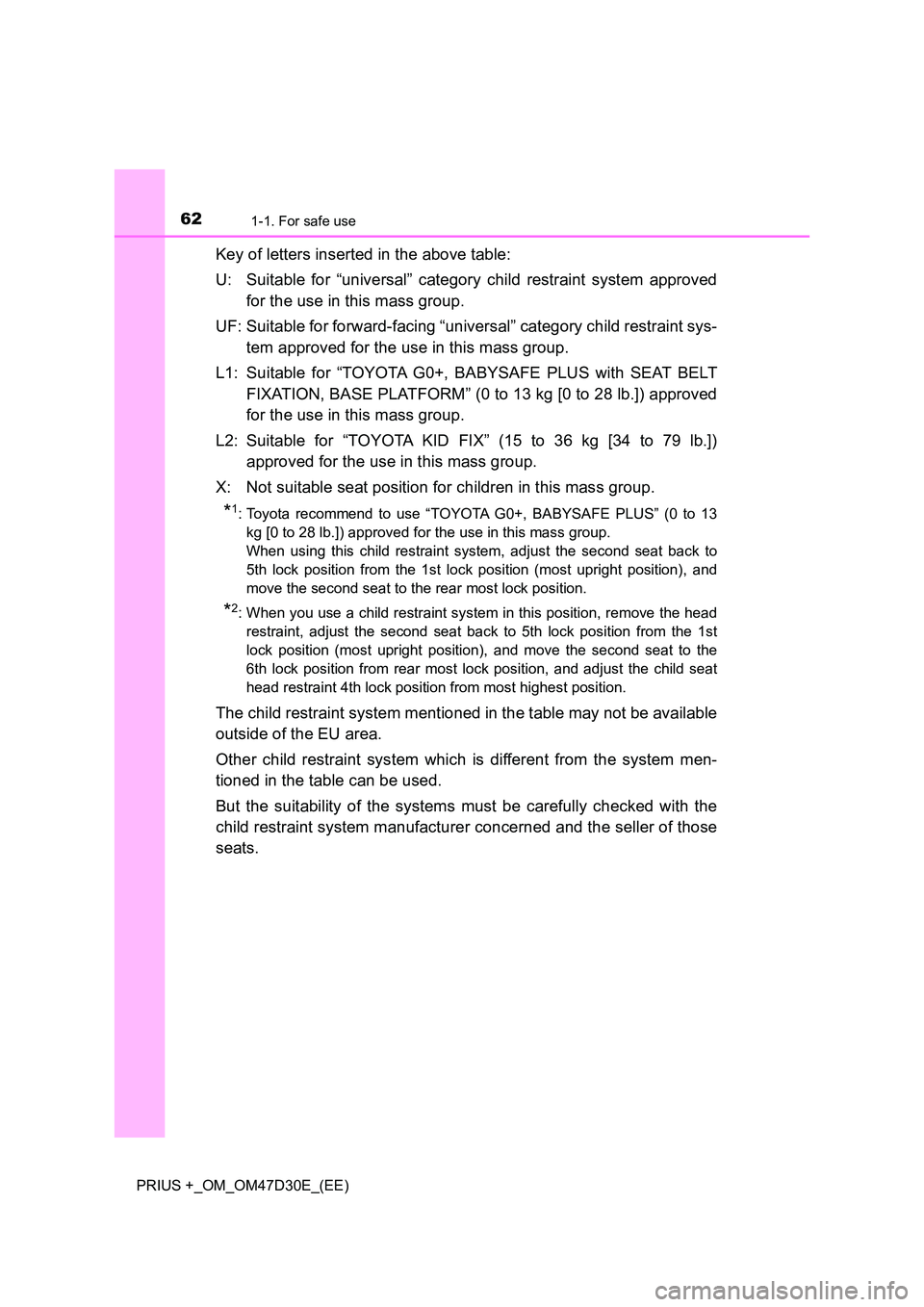Page 56 of 568
561-1. For safe use
PRIUS +_OM_OM47D30E_(EE)
Airbag manual on-off system
“PASSENGER AIR BAG” indi-
cator
The ON indicator light turns on
when the airbag system is on (only
when the power switch is in ON
mode).
Airbag manual on-off switch
This system deactivates the front passenger airbag, front pas-
senger knee airbag and front passenger side airbag.
Only deactivate the airbags when using a child restraint system
on the front passenger seat.
1
2
Page 57 of 568

571-1. For safe use
1
PRIUS +_OM_OM47D30E_(EE)
For safety and security
Insert the mechanical key into the
cylinder and rotate to the OFF
position.
The OFF indicator light turns on
(only when the power switch is in
ON mode).
■ “PASSENGER AIR BAG” indicator information
If any of the following problems occur, it is possible that there is a malfunction
in the system. Have the vehicle inspected by any authorized Toyota retailer or
Toyota authorized repairer, or any reliable repairer.
● Neither ON nor OFF comes on.
● The indicator light does not change when the airbag manual on-off switch is
switched to ON or OFF.
Deactivating the airbags for the front passenger
WARNING
■ When installing a child restraint system
For safety reasons, always install the child restraint system in a rear seat. In
the event that the rear seat cannot be used, the front seat can be used as
long as the airbag manual on-off system is set to OFF.
If the airbag manual on-off system is left on, the strong impact of the airbag
deployment (inflation) may cause serious injury or even death.
■ When a child restraint system is not installed on the front passenger
seat
Ensure that the airbag manual on-off system is set to ON.
If it is left off, the airbag may not deploy in the event of an accident, which
may result in serious injury or even death.
Page 58 of 568

581-1. For safe use
PRIUS +_OM_OM47D30E_(EE)
Safety information for children
●It is recommended that children sit in the rear seats to avoid acci-
dental contact with the shift lever, wiper switch etc.
● Use the rear door child-protector lock or the window lock switch to
avoid children opening the door while driving or operating the
power window accidentally. ( P. 147, 208)
● Do not let small children operate equipment which may catch or
pinch body parts, such as the power window, hood, back door,
seats etc.
Observe the following precautions when children are in the vehi-
cle.
Use a child restraint system appropriate for the child, until the
child becomes large enough to properly wear the vehicle’s seat
belt.
WARNING
Never leave children unattended in the vehicle, and never allow children to
have or use the key.
Children may be able to start the vehicle or shift the vehicle into neutral.
There is also a danger that children may injure themselves by playing with
the windows or other features of the vehicle. In addition, heat build-up or
extremely cold temperatures inside the vehicle can be fatal to children.
Page 59 of 568
591-1. For safe use
1
For safety and security
PRIUS +_OM_OM47D30E_(EE)
Child restraint systems
Studies have shown that installing a child restraint system on a rear
seat is much safer than installing one to the front passenger seat.
● Choose a child restraint system that suits your vehicle and is appro-
priate to the age and size of the child.
● For installation details, follow the instructions provided with the child
restraint system.
General installation instructions are provided in this manual.
( P. 6 7 )
● If child restraint system regulations exist in the country where you
reside, please contact any authorized Toyota retailer or Toyota
authorized repairer, or any reliable repairer for the child restraint
system installation.
● Toyota recommends that you use a child restraint system which
conforms to the regulation ECE No.44.
Toyota strongly urges the use of child restraint systems.
Points to remember
Page 60 of 568
601-1. For safe use
PRIUS +_OM_OM47D30E_(EE)
Child restraint systems are classified into the following 5 groups
according to the regulation ECE No.44:
Group 0: Up to 10 kg (22 lb.) (0 - 9 months)
Group 0+: Up to 13 kg (28 lb.) (0 - 2 years)
Group I: 9 to 18 kg (20 to 39 lb.) (9 months - 4 years)
Group II: 15 to 25 kg (34 to 55 lb.) (4 years - 7 years)
Group III: 22 to 36 kg (49 to 79 lb.) (6 years - 12 years)
In this owner’s manual, the following popular 3 types of child restraint
systems that can be secured with the seat belts are explained.
Types of child restraints
Baby seatChild seat
Equal to Group 0 and 0+ of ECE
No.44
Equal to Group 0+ and I of ECE
No.44
Junior seat
Equal to Group II and III of ECE
No.44
Page 61 of 568
611-1. For safe use
1
PRIUS +_OM_OM47D30E_(EE)
For safety and security
Information provided in the table shows your child restraint system
suitability for various seating positions.
Child restraint system suitability for various seating positions
Front passenger seat
Second seatThird seatAirbag manual
on-off switch
ONOFFOutsideCenter
0
Up to 10 kg
(22 lb.)
(0 - 9 months)
X
Never put
U
L1
U
L1
U
L1
U
L1
0+
Up to 13 kg
(28 lb.)
(0 - 2 years)
X
Never put
U
L1
U*1
L1
U
L1
U
L1
I
9 to 18 kg
(20 to 39 lb.)
(9 months -
4 years)
Rear-
facing —
X
Never put UUUU
Forward-
facing —
UF
II, III
15 to 36 kg
(34 to 79 lb.)
(4 - 12 years)
UF U U
L2*2UU
Seating
position
Mass groups
Page 62 of 568

621-1. For safe use
PRIUS +_OM_OM47D30E_(EE)
Key of letters inserted in the above table:
U: Suitable for “universal” category child restraint system approved
for the use in this mass group.
UF: Suitable for forward-facing “universal” category child restraint sys-
tem approved for the use in this mass group.
L1: Suitable for “TOYOTA G0+, BABYSAFE PLUS with SEAT BELT
FIXATION, BASE PLATFORM” (0 to 13 kg [0 to 28 lb.]) approved
for the use in this mass group.
L2: Suitable for “TOYOTA KID FIX” (15 to 36 kg [34 to 79 lb.])
approved for the use in this mass group.
X: Not suitable seat position for children in this mass group.
*1: Toyota recommend to use “TOYOTA G0+, BABYSAFE PLUS” (0 to 13
kg [0 to 28 lb.]) approved for the use in this mass group.
When using this child restraint system, adjust the second seat back to
5th lock position from the 1st lock position (most upright position), and
move the second seat to the rear most lock position.
*2: When you use a child restraint system in this position, remove the head
restraint, adjust the second seat back to 5th lock position from the 1st
lock position (most upright position), and move the second seat to the
6th lock position from rear most lock position, and adjust the child seat
head restraint 4th lock position from most highest position.
The child restraint system mentioned in the table may not be available
outside of the EU area.
Other child restraint system which is different from the system men-
tioned in the table can be used.
But the suitability of the systems must be carefully checked with the
child restraint system manufacturer concerned and the seller of those
seats.
Page 63 of 568
631-1. For safe use
1
PRIUS +_OM_OM47D30E_(EE)
For safety and security
Information provided in the table shows your child restraint system
suitability for various seating positions.
Child restraint system suitability for various seating positions
(with ISOFIX rigid anchor)
Mass groupsSize classFixture
Vehicle ISOFIX
positions
Second outside seat
Carrycot
FISO/L1X
GISO/L2X
(1) X
0
Up to 10 kg (22 lb.)
(0 - 9 months)
EISO/R1IL
(1) X
0+
Up to 13 kg (28 lb.)
(0 - 2 years)
EISO/R1IL
DISO/R2IL
CISO/R3IL
(1) X
I
9 to 18 kg (20 to 39 lb.)
(9 months - 4 years)
DISO/R2X
CISO/R3X
BISO/F2IUF*, IL*
B1ISO/F2XIUF*, IL*
AISO/F3IUF*, IL*
(1) X
II, III
15 to 36 kg (34 to 79 lb.)
(4 - 12 years)
(1) X